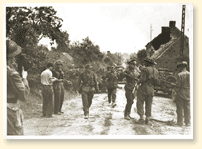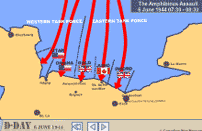

German troops surrendering to the South Alberta Regiment at St-Lambert-sur-Dives in the
"Falaise Pocket," August 1944. Major D.V. Currie, on the left with a pistol in hand, won the
Victoria Cross, the highest combat decoration in the British Commonwealth, for his leadership in
these operations.
Canadian Military Photograph |

Interactive Map of D-Day and the Invasion of Normandy showing Canadian Operations, from June 4 to June 12, 1944
* Flash Player version 6 required
Best viewed at 800x600 resolution |
D-Day and the Normandy Campaign
On June 6, 1944, the "Second Front" became reality.
Anglo-American-Canadian forces landed on the open beaches of
Normandy, north and west of the city of Caen. In the weeks before
that, the Allied
had attacked the transportation network
used to move German troops and equipment. On
itself, delayed one day by bad weather in the English Channel, powerful air
and naval support as well as ground-breaking specialized armoured
vehicles, such as tanks capable of "swimming", helped the infantry
to get ashore on five beaches - two each for the American and
British and one for the Canadians. At the end of the first day, the
Allies held a thin beachhead, but had suffered fewer casualties than
they expected.
Hard battles followed. At last, west of St.Lô, the Americans broke
through the German lines in August 1944. An armoured counterattack
ordered by Hitler was broken up by British rocket-firing Typhoon
fighter-bombers and American tanks. As the Germans retreated west,
they were trapped in the "Falaise Pocket" between the British and
Canadians to the north and the onrushing Americans to the south.
Although the Canadians were slow to close the gap at the east end of
the pocket, some 50,000 German soldiers were killed and 200,000
taken prisoner. The German
lost most of its armour and vehicles in France.
3rd Canadian Infantry
and 2nd Canadian Armoured
formed the Canadian assault force on , while
1st Canadian Parachute jumped as part of the great
force protecting the flanks of the landings. Canadian destroyers,
corvettes, minesweepers, landing ships and landing craft supported
the landings, as did the many squadrons
overhead. At first, the Canadians came ashore under British command, but
with the arrival of 2nd Canadian Infantry
and 4th Canadian Armoured
in July, all came under the command of their own leaders in the First
Canadian .
Related Newspaper Articles
English Articles
- This Crowded Hour
The Hamilton Spectator, 06/06/1944
- Canadians Move in Quickly After Smashing Back Stiff Hun Resistance
on Beaches
The Hamilton Spectator, 07/06/1944
- Canadian Navy Prominent As Invasion Armada Sailed
The Hamilton Spectator, 08/06/1944
- "A Great Crusade" : Quotation of a Fateful Week
The New York Times, 11/06/1944
- Letter from France
The Globe and Mail, 12/06/1944
- Normandy Is Like Home for French-Canadians
The Globe and Mail, 19/06/1944
- Rocket-Firing typhoons ease Canadians' burden
The Globe and Mail, 08/07/1944
- Twilight of Youth
The Globe and Mail, 11/07/1944
- Whole American Army On the Move In France, Headquarters States
The Globe and Mail, 15/07/1944
- Allies closing in From Three sides on Desperate Foe
The Hamilton Spectator, 12/08/1944
- Channel Swept Free Of Mines For D-Day Path
The Hamilton Spectator, 09/09/1944
- Reveals D-Day Was Postponed At Last Minute
The Hamilton Spectator, 31/10/1947
French Articles
-
L'arrivée des Canadiens à Carpiquet
Le Devoir, 08/07/1944
-
Les Canadiens sont les premiers à entrer à Caen
Le Devoir, 10/07/1944
-
Offensive alliée sur la route de la Falaise
Le Devoir, 25/07/1944
-
Les Fusiliers Mont-Royal en Normandie
Le Devoir, 26/07/1944
-
Exploits du Régiment de la Chaudière
Le Devoir, 05/08/1944
-
Une armée canadienne combat en France
Le Devoir, 07/08/1944
-
L'armée canadienne du général Crerar marche sur Falaise
Le Devoir, 09/08/1944
-
Les Canadiens continuent de se rapprocher de Falaise
Le Devoir, 10/08/1944
-
Brèche dans le front allemand de la Loire. Les Canadiens tiennent ferme à Falaise...
Le Devoir, 12/08/1944
-
Offensive majeure pour encercler les Allemands
Le Devoir, 14/08/1944
-
Actes héroïques des Fusiliers Mont-Royal
Le Devoir, 17/08/1944
-
L'assaut des Fusiliers Mont-Royal en Normandie
Le Devoir, 17/08/1944
-
Les Canadiens ne doivent pas reculer. Le commandant du Régiment de la Chaudière...
Le Devoir, 18/08/1944
-
Le métier d'artilleur
Le Devoir, 22/08/1944
-
Quelques exploits des Fusiliers Mont-Royal
Le Devoir, 23/08/1944
-
Avec les Fusiliers Mont-Royal outre-mer
Le Devoir, 25/08/1944
-
Comment nos gars se battent
Le Devoir, 31/08/1944
-
Le régiment de Sherbooke dans la bataille
Le Devoir, 07/09/1944
-
Les Canadiens en suisse normande
Le Devoir, 07/09/1944
-
Nos entrevues. Le général Keller
Le Devoir, 20/10/1944
|